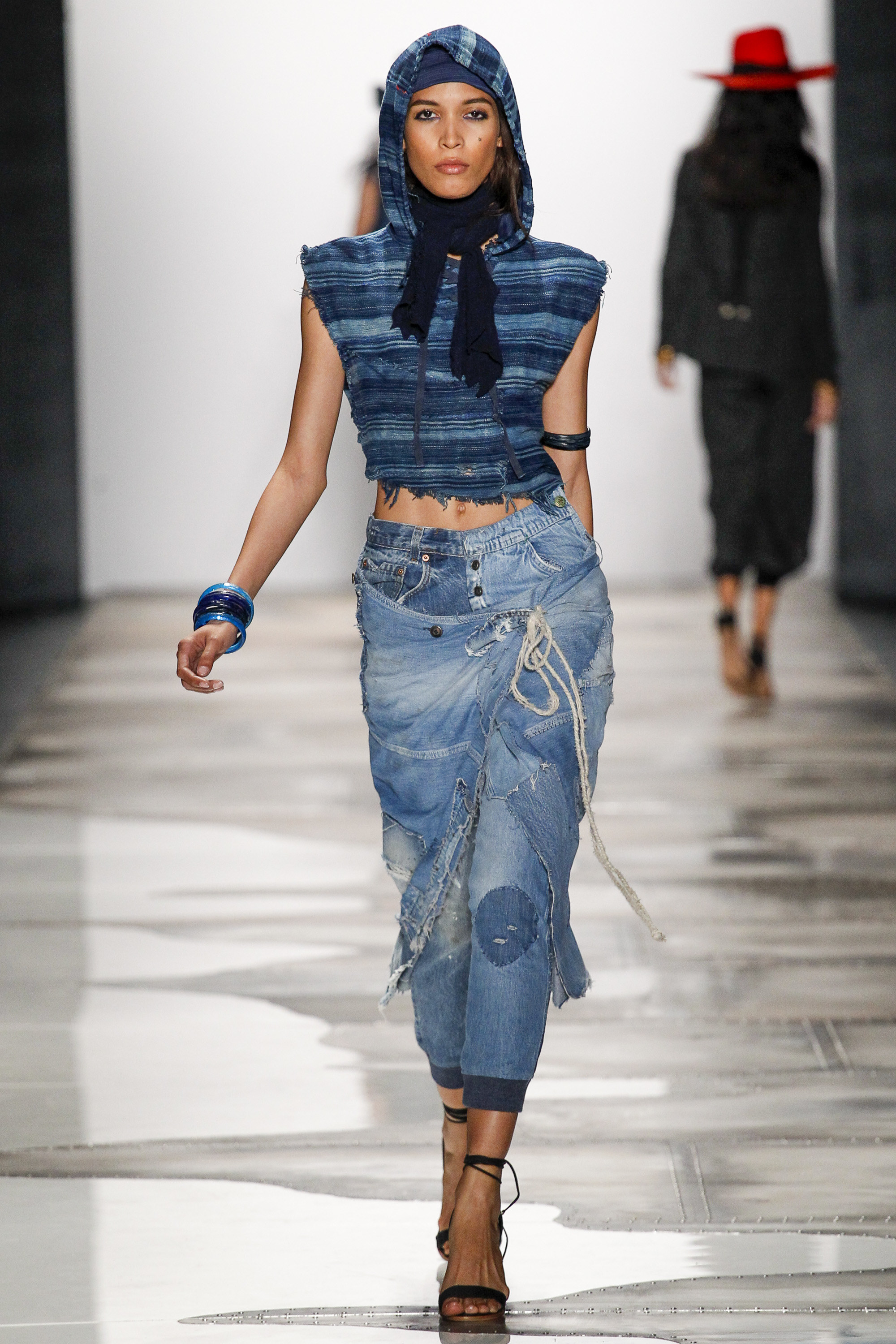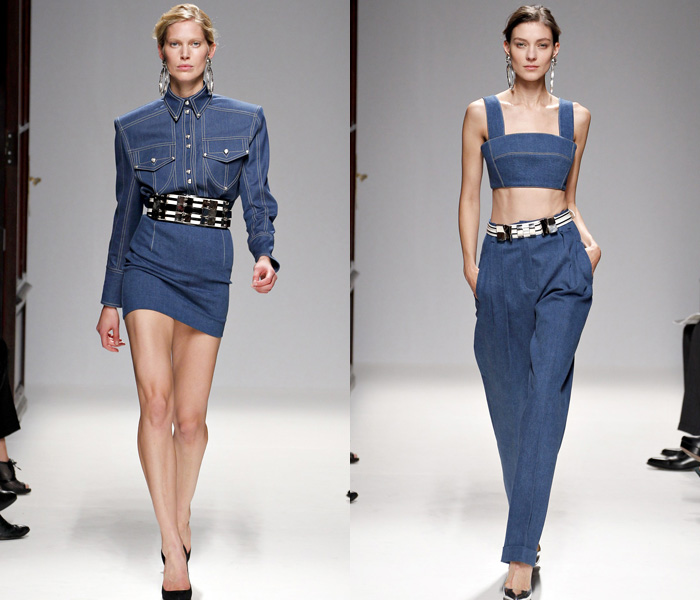Denim duds…a main staple of American (and world) fashion! Where would we be without denim clothing? Almost as lost as when Chevrolet discontinued the Camaro (a muscle car of vast performance)…until Chevrolet redeemed that mistake and brought the popular car back on the market. Vroom, vroom!
Denim is a sturdy cotton warp-faced textile in which the weft passes under two or more warp threads. This twill weaving produces a diagonal ribbing that distinguishes it from cotton duck. “Quack, quack…those are some mighty fine denim duds you’ve got on there!”
While denim is a popular material for jeans, denim makes for fabulous dresses, skirts, jackets, purses, shoes, overalls, etc. Pretty much any garment can pull off denim. Do I hear a denim wedding dress, anyone?
Blue Jean Denim Fun Fact: The most common denim is indigo denim, in which the warp thread is dyed, while the weft thread is left white. As a result of the warp faced twill weaving, one side of the textile is dominated by the blue warp threads and the other side is dominated by the white weft threads. This causes blue jeans to be white on the inside. The indigo dyeing process, in which the core of the warp threads remains white, creates denim’s signature fading characteristics.
Ah, interesting information indeed! The denim textile dyeing weave!

The name ‘denim’ derives from the French serge de Nimes, meaning “serge from Nimes.”
Denim was traditionally colored blue with indigo dye to make blue jeans, although “jean” formerly denoted a different, lighter, cotton fabric. The contemporary use of the word “jeans” comes from the French word for Genoa, Italy (Genes), where the first denim trousers were made.
Delicious, dazzling, delightful denim duds!
Denim Fun Fact: Denim has been used in the United States since the mid 19th century. Denim initially gained popularity in 1873 when Jacob Davis, a tailor from Nevada, manufactured the first pair of ‘rivet-reinforced’ denim pants. His concept for making reinforced jeans was inspired when a female customer requested a pair of durable and strong pants for her husband to chop wood in. When Davis was about to finish making the denim jeans, he saw some copper rivets laying on a table and used the rivets to fasten the pockets. Necessity, the mother of invention!
Dry denim (or raw denium) is denim that isn’t washed after having been dyed during production. Over time, dry denim will usually fade, which is considered desirable by some people. During the process of wear, fading will usually occur on those parts of the material that receives the most stress.
“My dear, how would you like your denim?”
“Faded, ripped, threaded and shredded!”
Who knew that type of denim would become a mainstream fashion must have?

Washed Denim Fun Fact: After being made into an article of clothing, most denim garments are washed to make them softer and to reduce or eliminate shrinkage. In addition to being washed, washed denim is sometimes artificially distressed to produce a worn look. Much of the appeal of artificially distressed denim is that it resembles dry denim which has faded. In jeans made from dry denim, fading is affected by the body of the person who wears them and by the activities of their daily life. This process creates a more natural look rather than an artificially distressed denim.
Downright darling, your denim duds!

One thing is certain with denim. The sturdy material creates garments of upscale, youthful appeal, as well as an overall look of casual…as in, well, denim overalls!
For those that adore faded jeans:
Patterns of Fading:
- Combs or Honeycombs – Faded lines that are found behind the knees.
- Whiskers – Faded streaks that surround the crotch area of the jeans.
- Stacks – These are created by having the inseam of the jeans hemmed a few inches longer than the actual leg length. The extra fabric stacks on top of the shoe, causing a faded area to form around the ankle, extending to the upper calf.
- Train Tracks – These appear on the outseams of the denim. This pattern showcases the selvage by forming two parallel lines of fades, which resemble train tracks.
Denim Fun Fact: Denim was originally dyed with a dye produced from the plant Indigofera trintoria, but most denim today is dyed with synthetic indigo dye. In both cases, the yarn undergoes a repeated sequence of dipping and oxidation – the more dips, the stronger the color of the indigo.
Dip that dyed denim, darling!
Denim fabric dying is divided into two categories:
- Indigo Dying – Produces the traditional blue color and similar blue shades.
- Sulfur Dying – Produces specialty black colors with other colors, such as red, pink, purple, grey, rust, mustard and green.
No matter the denim color, blue, red, black or green, you’ll always be a fashion hit in denim on any style scene!

Whether you prefer to wear your denim ripped or solid, it’s your choice. Create your own unique fashion voice!

Denim duds: Always a hit, never a miss. Now give those favorite jeans of yours a thank you kiss!
“My denim jeans outshine your denim jeans.”
“But the style of our jeans looks very much the same.”
“Mine aren’t faded, are neatly pressed, the material even and long.”
“Mine are faded, ripped, shredded and cut…definitely fashion strong.”
“Mine have more fabric and look more expensive. I paid a hefty price.”
“My tattered denim look is free…I tore them up myself. Ah, fashion nice!”
Denim sugar and spice. No matter how you prefer to wear your denim, don’t allow anyone to make you think twice!

Nancy Mangano is an American fashion journalist and author of the Natalie North murder mystery book series, A Passion for Prying and Murder Can Be Messy. Visit Nancy on her author website http://www.nancymangano.com, Twitter @https://twitter.com/nancymangano, her fashion magazine Strutting in Style! at https://nancymariemangano.com, and her Facebook fan page Nancy Mangano https://www.facebook.com/pages/Nancy-Mangano/362187023895846